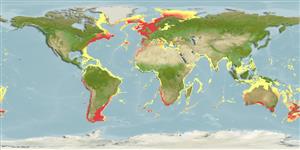Classificação / Names
Common names from other countries
Issue
Squalus suckleyi (Girard, 1855) has been resurected by Ebert et al. (2010: Ref. 85328) in the North Pacific where it replaces Squalus acanthias Linnaeus, 1758.
Referência principal
Tamanho / Peso / Idade
Max length : 160 cm TL macho/indeterminado; (Ref. 247); common length : 100.0 cm TL macho/indeterminado; (Ref. ); Peso máx. publicado: 9.1 kg (Ref. 11389); Idade máx. registada: 75 anos (Ref. 39247)
Length at first maturity
Lm 81.4, range 69 - 100 cm
Ambiente
; marinhas; estuarina bentopelágico; oceanódromo (Ref. 51243); intervalo de profundidade 0 - 1460 m (Ref. 26346), usually 50 - 300 m (Ref. 43939)
Clima / Intervalo
Temperate; 7°C - 15°C (Ref. 247), preferred 16°C (Ref. 107945); 81°N - 57°S, 82°W - 171°W (Ref. 247)
Distribuição
Western Atlantic: Greenland to Argentina; Eastern Atlantic: Iceland and and the Barents Sea to Western Sahara and the Canary Islands; Angola to South Africa. Indo-Pacific; the Mediterranean and Black Seas (Ref. 247) Reports from off New Guinea are doubtful (Ref. 6871). All records from North Pacific refer to Squalus suckleyi (Girard, 1855) (Ref. 85328). Appendix II (northern hemisphere populations) of the Bonn Convention (2009).
Países | Áreas FAO | Ecossistemas | Ocorrências | Introduções
Descrição breve
Espinhos dorsais (total): 2; Raios dorsais moles (total): 0; Espinhos anais 0; Raios anais moles: 0; Vértebras: 101 - 109. This moderately sized species is distinguished by the following set of characters: very slender body, abdomen width 7.2-9.2% TL; narrow head, width at mouth 7.9-10.2% TL; mouth width 1.7-2.2 times its horizontal prenarial length; moderately long snout, preoral length 2.2-2.5 times horizontal prenarial length, 8.5-9.8% TL; single-lobed anterior nasal flap; small dorsal fins, raked, first dorsal-fin height 1.1-1.3 times its inner margin length, second dorsal-fin height 0.7-0.9 times its inner margin length; origin of first dorsal-fin located just posterior to pectoral-fin free rear tips; exposed bases of dorsal-fin spines relatively narrow, 0.4-0.7% TL; short spine of first dorsal fin, exposed length 1.7-2.7% TL; pectoral-fin anterior margin 1.9-3.1 times its inner margin length; preventral caudal margin 1.9-2.6 times inner margin of pelvic fin; pale caudal fin with poorly demarcated, whitish margin, blackish caudal blotch at the apex of upper lobe, anterior margins of both lobes whitish in juveniles; dark caudal bar absent; dorsal and lateral surfaces of body bluish grey with an irregular array of moderately-large white spots; whitish ventrally; flank denticles tricuspid; monospondylous centra 41-45, precaudal centra 74-79, total centra 100-105 (Ref. 58446).
Categoria na Lista Vermelha da IUCN (Ref. 115185)
Utilização humana
Pescarias: espécies comerciais; peixe desportivo: sim
Ferramentas
Relatórios especiais
Descarregue XML
Fontes da internet
Estimates of some properties based on models
Phylogenetic diversity index
PD50 = 0.5000 many relatives (e.g. carps) 0.5 - 2.0 few relatives (e.g. lungfishes)
Nível Trófico
4.4 ±0.4 se; Based on diet studies.
Resiliência
Muito baixo, tempo mínimo de duplicação da população maior que 14 anos (rm=0.034; K=0.03-0.07; tm=10-30; tmax=75; Fec=1)
Vulnerabilidade
High to very high vulnerability (68 of 100)
Categoria de preço
